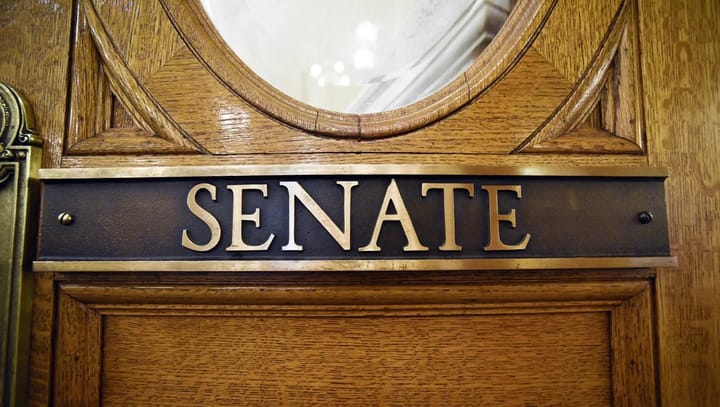South Dakota predator bounty program to continue despite opposition
Despite data or evidence, state is 'confident that this bounty program is enhancing nest success.'
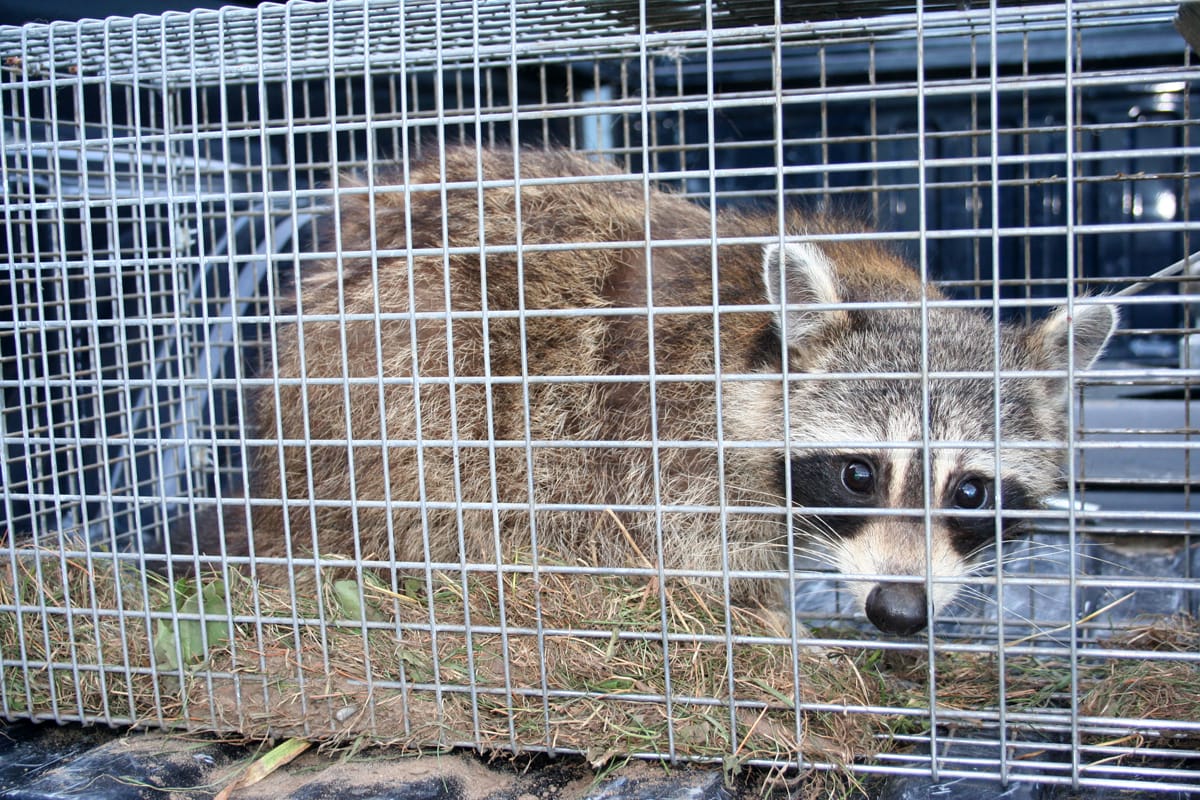
Editor's note: This story was first published in 2021 and has been updated.
A state-sanctioned pheasant protection program that pays South Dakota youths and adults $10 for every raccoon, skunk and other predator they trap and kill will continue through 2026.
Known as the Nest Predator Bounty Program, the effort has led to the killing of more than 240,000 animals in the past five years with no scientific evidence that it is working to increase the state pheasant population.
The effort to boost pheasant and duck populations by paying trappers to kill animals that eat the eggs and hatchlings of pheasants and ducks began in 2019. The program occurs for a few months during the spring pheasant nesting season.
Little common ground can be found in assessing the merits or methods of the program, which has been described as both a wildlife-management success and an inhumane, senseless killing of wild animals.
Some state officials, including Gov. Kristi Noem, who first implemented the program, and Game, Fish and Parks Secretary Kevin Robling, see the bounty program as an effective method to reduce predation on pheasants and encourage young people to get outside and take up trapping as a hobby.
Opponents argue the program is not based on science, needlessly kills animals and may upset the natural ecosystem, and improperly uses financial incentives for children and adults to trap and kill animals whose carcasses are discarded after the tails are turned in for a bounty.
In 2023, the program started in April and ended on June 29 when the limit on tail payments was reached. The 2023 program resulted in the killing of 50,800 animals – about 42,300 of them raccoons – by roughly 2,500 participants. Top counties for tail submissions were Minnehaha (5,600 tails) and Brookings (2,540), followed by Roberts (2,060), according to GFP data. The program set a record for youth participation rate with 46% of trappers aged 18 or under.
Program faces opposing viewpoints
“It’s really a success story when you look at enhancing our trapping traditions and outdoor heritage,” Robling said in 2021.
He acknowledges there is no data or concrete evidence to show that the bounty program has improved pheasant or duck numbers or enhanced successful nesting rates, but he remains convinced it is working.
“As far as quantifying pheasant abundance, we don’t have any research design set up for that,” Robling said. “But we are confident that this bounty program is enhancing nest success.”
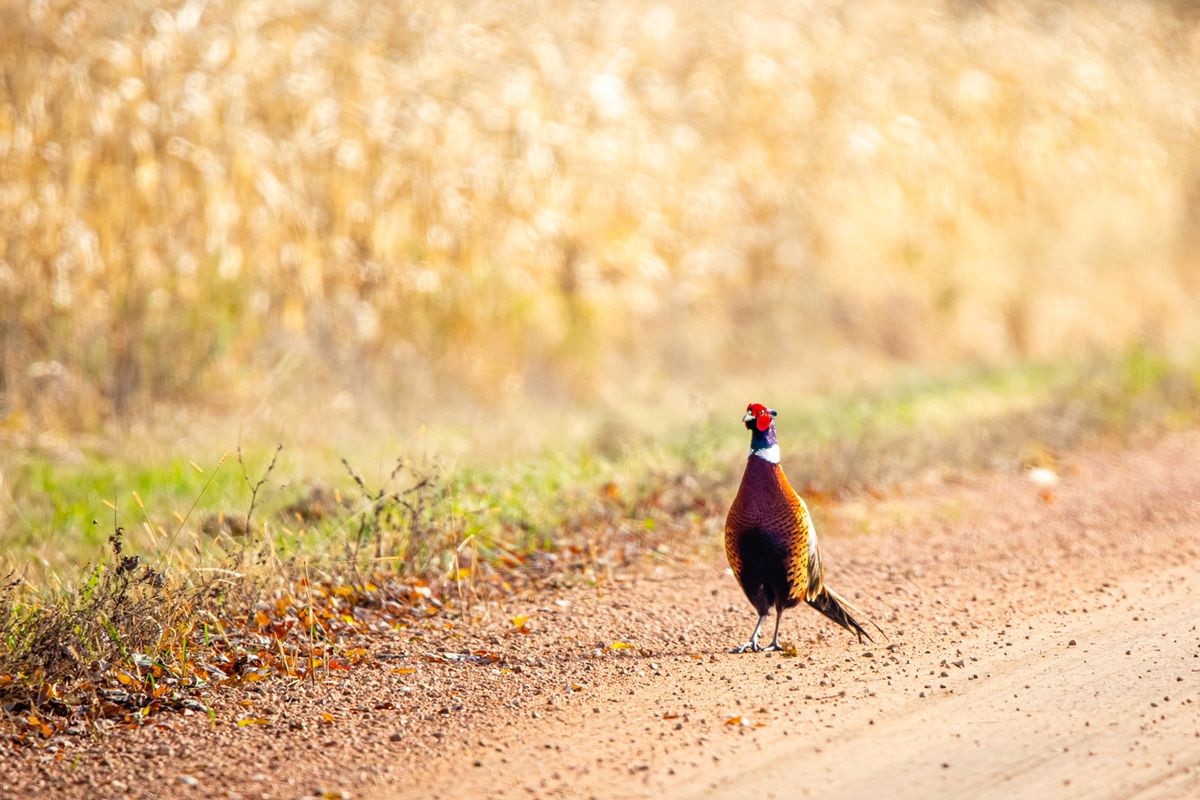
Opponents of the program, including some influential members of the South Dakota wildlife management community, are less confident that paying youths and adults to kill five species of animals is a proper way to boost pheasant and duck populations.
When Gary Jensen, a Rapid City lawyer, served as chair of the GFP Commission in 2020, he voted against the resolution to extend the bounty program.
“There’s no science that supports it,” Jensen said. “The department can’t show any evidence on the bounty program and it doesn’t have any program in place to determine if it’s increasing pheasant numbers.”
Inside the Nest Predator Bounty Program
The bounty program was first implemented in 2019 by Noem as part of her Second Century Initiative, aimed at protecting and expanding pheasant habitat and populations in the state. In January, the South Dakota Game Fish & Parks Commission approved the program’s continuance.
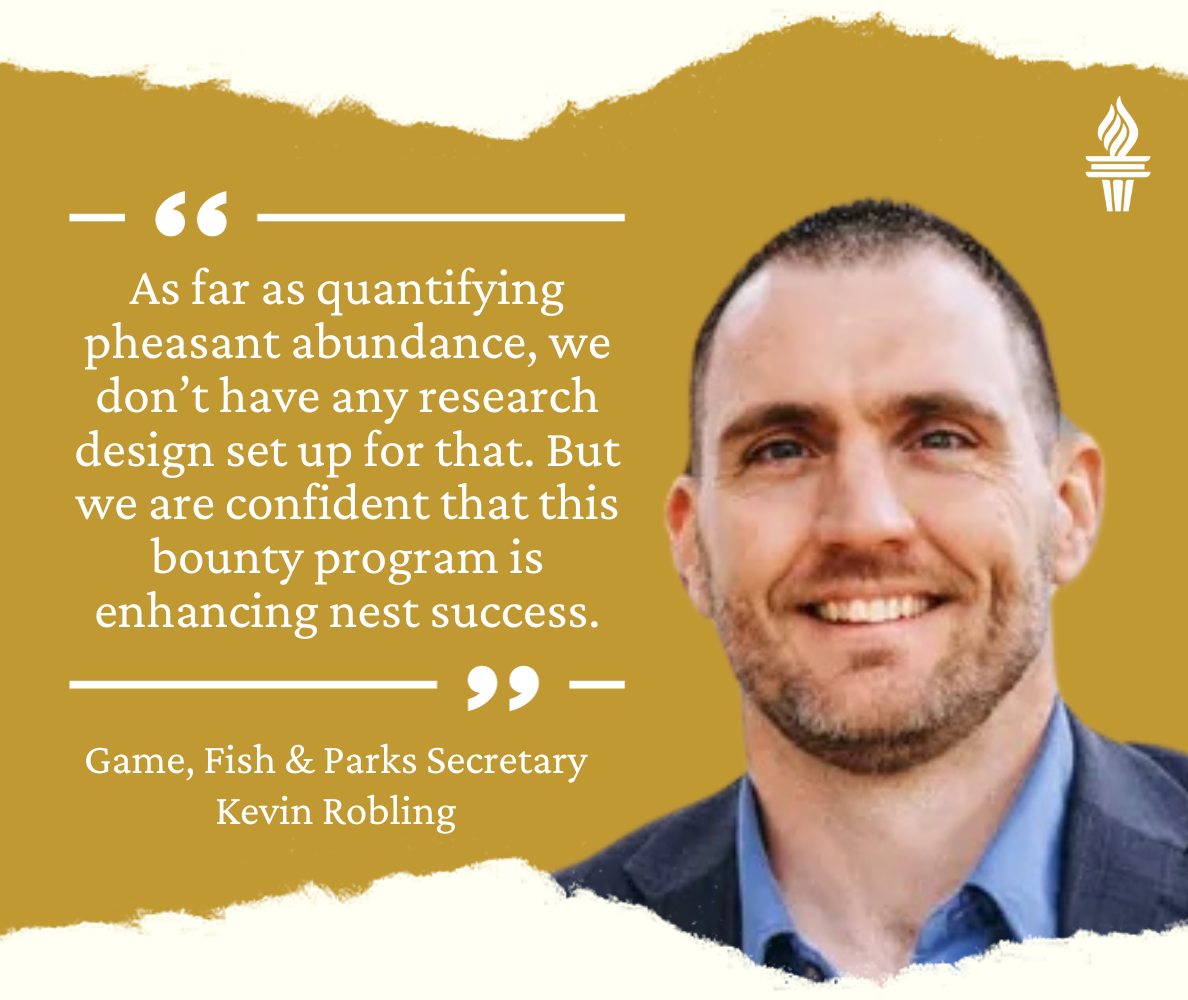
On a basic level, the program works like this: Adults licensed to trap or youths who want to participate bait traps from April through July to capture animals, which they then typically kill with a rifle. The tails of the animals are cut off, collected and submitted to the state at designated locations. Participants are then paid $10 for each qualifying tail.
Target animals include raccoons, the most frequently bountied animals, as well as skunks, opossums, red foxes and badgers. The carcasses of the animals, which are not good to eat, are discarded, though some may have pelts removed first. The state encourages participants to bury the carcasses but there are no requirements to do so, Robling said.
The program has an annual $500,000 maximum for the payment of collected tails.
Trapping program draws backlash
Public opposition to the program has grown over time. The state sanctioned a survey early on during the program that showed 78% of about 400 random respondents strongly or moderately approved of the program after questioners explained to them the rationale behind it. However, 62% of those respondents said they knew nothing about the program before being called.
In March 2020, before the GFP Commission was about to vote to extend the program, which it ultimately did, about 400 public comments were received regarding the bounty program, more than 90% of those in opposition.
Some public commenters called the program “brutal,” “cruel,” “senseless” and “inhumane.” Others argued that it was simply a waste of money, had no proven results in regard to propagation of pheasants or ducks, and had led to the killing of helpless animals by trappers, including children, seeking a payment.
The program has also come under criticism for how it was implemented. Critics say Noem initiated the program largely outside the typical process of review by the public and the GFP Commission, which sets policy. Noem’s office did not respond to inquiries from News Watch in 2021 and referred all questions to the GFP.
A program with a purpose
Robling said the two main goals of the predator bounty program are to strengthen pheasant and duck populations in the wild by reducing the number of prey animals and to get more South Dakota youth engaged in outdoor activities, specifically trapping.
Robling said he looks at successful propagation of the state’s pheasant population as a “three-legged stool” that relies on weather, habitat and predator management.
Stable weather patterns that aren’t too wet or too dry, especially in the spring hatching season, are positive for pheasants, Robling said.
But with the weather an unpredictable and uncontrollable force, Robling said the state focuses on the other two components of pheasant population management. Habitat management and the predator bounty program are key parts of those efforts, Robling said.
The state lost one of its only measures to estimate the pheasant population when the GFP Commission voted to end its annual roadside brood count of young pheasants after 2019.
Robling said the bounty program has a proven track record of preserving the state’s hunting and trapping heritage by encouraging more young people to become active in the outdoors.
In the first year, 11% of bounty program participants were under age 18. That percentage rose 13% the second year, and in 2021, 29% of the 2,800 participants in the bounty program were under 18, Robling said.
“We are absolutely seeing more engagement with your youth, so that’s a metric where we’re clearly seeing success,” he said.
Studies doubt success of predator-control programs
Predator control methods, and paid bounty programs in particular, are a controversial way of protecting desirable species of animals. The science regarding success of the programs is also murky at best.
South Dakota’s program is unique in the number of species of animals targeted. However, bounty programs on coyotes are common throughout the American West. And Florida has an ongoing bounty program that pays trappers to remove invasive pythons from the Everglades.
One study published in 2016 in the scientific journal “Frontiers in Ecology and the Environment” reviewed 12 other studies of predator-control programs to protect livestock in North America and Europe. The review found that six predator-removal efforts (two lethal, four non-lethal) ultimately led to successful protection of livestock. Two led to a greater predation on livestock and four had no effect.
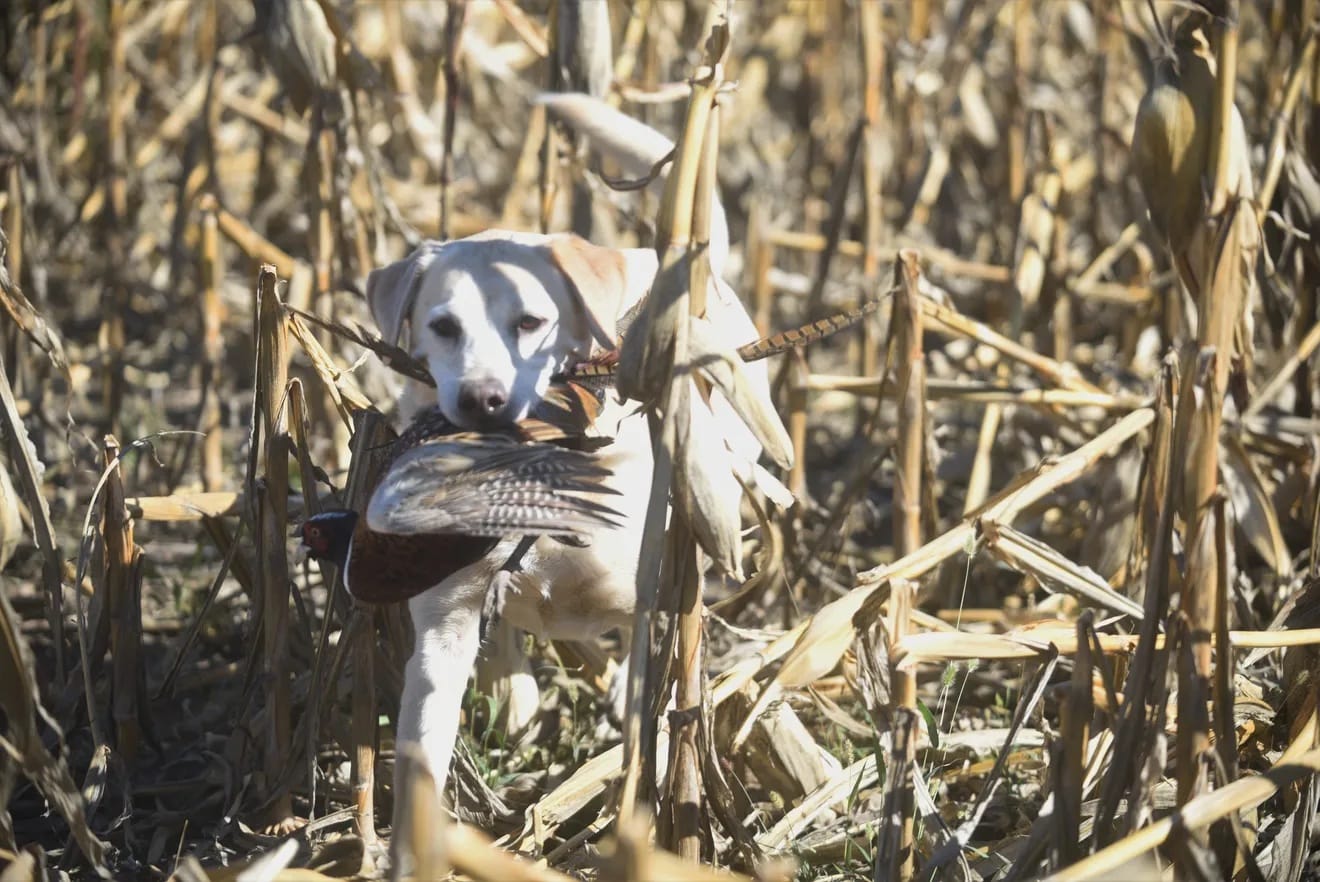
It is notable that the predator-control efforts reviewed in the study were performed under highly controlled conditions and did not include bounty programs involving members of the public.
In the end, the study authors recommended that only predator-control programs that are closely monitored and show scientifically proven results be continued.
“We recommend that policymakers suspend predator control efforts that lack evidence for functional effectiveness and that scientists focus on stringent standards of evidence in tests of predator control,” the study reported.
A more specific study reported in the journal “Wildlife Biology” that examined predator-control efforts to boost grouse populations also concluded that wide-scale, long-term, lightly regulated predator-control programs often do not have the intended effect of protecting a desired species.
“Our results suggest that predator control is likely to achieve short-term conservation benefits for grouse if well-designed and rigorously conducted. We suspect, however, that the majority of control programs conducted for conservation do not meet this standard,” the 2019 study said.
Research questions program’s success
Robling provided News Watch with links to two research articles indicating that predator control can be a successful component of protecting pheasants and boosting nesting success.
A 2001 article in the “Wildlife Society Bulletin” notes that pheasant breeding success has fallen as grasslands have been increasingly converted to row cropping, a historical land-use pattern common to South Dakota.
That article also points out that while predator control can boost pheasant populations, the researchers raise questions about the cost and how long such efforts must continue in order to be effective.
“Predator reduction programs have the potential to increase survival and recruitment, but these parameters decrease once predator control ceases,” the article states.
The article also notes that “extensive application of predator reductions may be ethically questionable” and concludes that although predator-removal programs can be part of a larger effort to protect pheasants, the science around predator control is ultimately inconclusive and can have unanticipated consequences.
“The role of mammalian predators in midwestern pheasant population declines is complex and unclear,” the article says in its conclusion. “Previous research suggests that mammalian predators can cause a significant decrease in pheasant survival during periods of severe winter weather and during the nesting season. Reducing densities of one predator species, however, may only be compensated by other predator populations.”
Study unsure of program’s effectiveness
Another research article suggested by Robling, a 2011 master’s thesis paper written by a student at South Dakota State University, compared pheasant and duck brood success on “control" plots of land where predator removal did not occur with brood success on “treatment” plots where predators, primarily coyotes, were removed by trapping.
The results of the study of so-called block predator management in eastern South Dakota appeared to be inconclusive in regard to the effectiveness of wide-scale predator-removal efforts.

Statistical analysis of nest success “for both ducks and pheasants indicated that there was no difference … between control sites and treatment sites,” the paper concluded.
However, the student noted his belief that predator management “had positive effects in some blocks during some years.” But he ultimately found that “(in) areas where adequate habitat is present on the landscape and birds are capable of high production, a program like BPM is not necessary and funds would be better spent elsewhere.”
A 'small scale remedy'
Pheasants Forever, the national group that supports pheasant hunting and protection of habitat, appears to take a lukewarm approach to wide-scale predator-removal programs.
In a position paper on its website that does not directly mention bounty programs, Pheasants Forever refers to predator-trapping programs as a “small scale remedy” that can show success in a limited geographic area.
Instead, the organization supports habitat management, rather than trapping and killing, as a way to reduce or successfully manage predator populations.

The paper concludes, “While predator removal and exclusion methods can increase nesting success on small areas, these methods are too expensive for use on a landscape basis and do not significantly increase the number of nesting birds over the long term.”
Extensive research and reviews of previous predator-bounty programs have revealed a consistent pattern of failure, said Gilbert Proulx, director of science at Alpha Wildlife Research & Management, a consulting firm in Alberta, Canada, which does work in Canada and Western U.S. states.
Proulx, who has authored more than 450 research articles and studies over the past 45 years, said very few bounty programs have shown success, and only when the effort is concentrated in a small geographic area and a limited amount of time.
For example, he said, it may help a small population of desirable animals or waterfowl to kill or remove the predators that hunt them in a single isolated marsh or wetland.
“Bounties are not well understood and are not truly successful,” Proulx said. “If you look at the history of animal bounties across North America, they did not create the result we expected, and often, there are unexpected consequences.”

Bounty programs that target small to medium-size ground-dwelling predators, such as the South Dakota program, can lead to unwanted outbreaks of squirrels, rats, mice and insects, Proulx said.
Another potential outcome shown in numerous studies is that when a predator population is reduced through a bounty program, subsequent broods of those predators are larger than in the past and the resulting animals are hardier and more resistant to illness than before, Proulx said.
Shifting the focus to habitats
The most successful method of propagating a desired species is to expand habitat or enhance existing habitat, Proulx said.
In most cases, bounty programs in Canada and the United States have been done to make political gains or to give the appearance that governments are actively trying to manage a population of animals and satisfy demands of sportsmen’s groups and the hunting industry.
“Bounties are a joke, a solution often brought on by government agencies trying to satisfy an industry and by politicians trying to get votes,” Proulx said.
Hunting and trapping in a carefully managed way, and then using related license fees to create habitat, is a much more sensible way to support healthy populations of wildlife, Proulx said.
“In order to live with wildlife, we need to hunt and trap and manage habitat,” he said. “Populations of wildlife take care of themselves better when they are not being shot to death on a wide scale.”
Proulx further noted that bounty efforts do not work well when citizens are encouraged to remove or kill animals on a large scale. Rather, he said, wildlife management is best done by professionals or government employees who can closely monitor the targeted predator population and the population being protected.
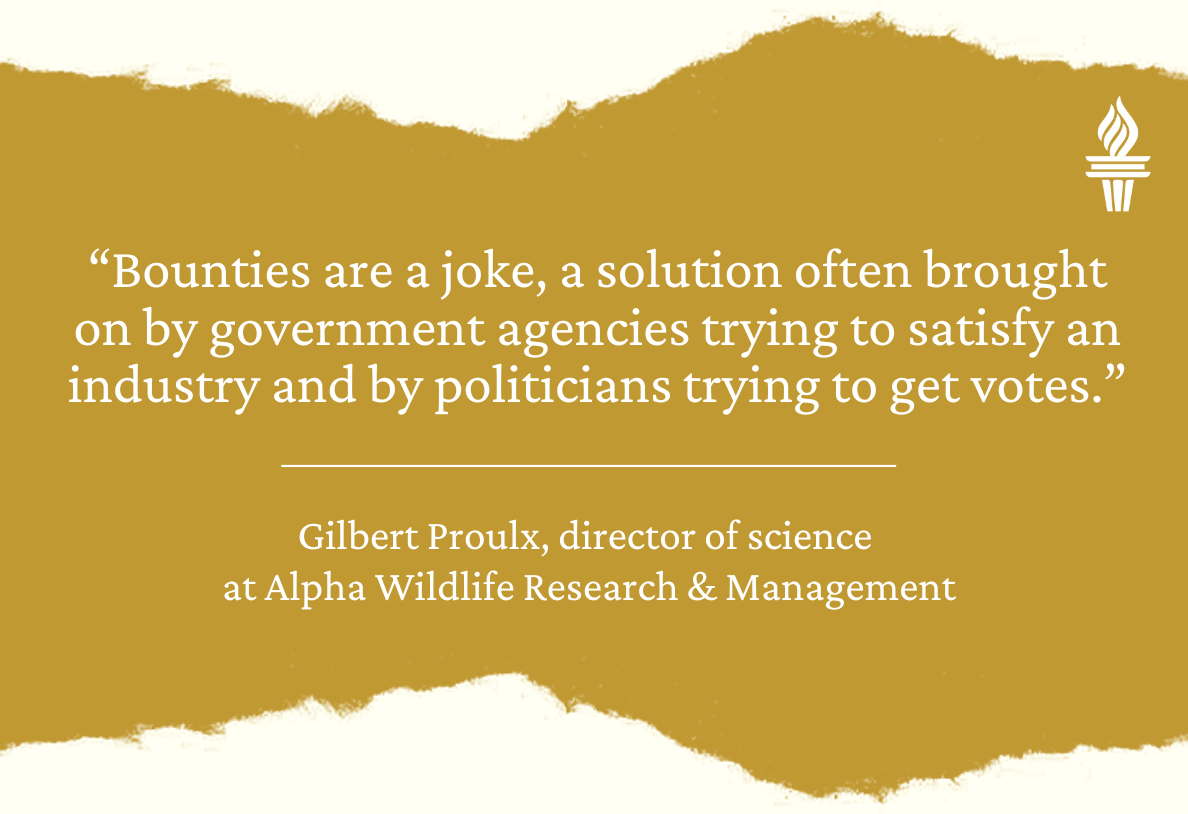
“I never saw a bounty system work in the long term because there are just too many factors and situations where the bounties are not properly applied,” Proulx said.
Pheasant and waterfowl populations in the Great Plains have been hurt far more by loss of habitat and the too-wet or too-dry weather conditions caused by climate change than by predation by other animals, he said.
“It’s mostly a question of maintaining the habitats,” Proulx said. “If you provide species with good habitats, such as cover and food, that is the most effective way to protect the populations.”
Former GFP secretary opposes bounty program
Former GFP secretary John Cooper wrote a detailed letter to Noem and the GFP commission in March 2019 expressing opposition to the predator bounty program. In particular, he noted that the program and related expenditures were not put through the typical process of vetting and consideration by either the commission or the public.
“It is frankly disturbing that the details of the program, which comes with a large price tag, were not disclosed to the very people (GFP Commission) who have the responsibility for budget transparency and accountability in our state government,” he wrote in the letter that was endorsed by 11 wildlife groups and outdoor associations.
The letter also stated that license revenues could be better spent on habitat creation or protection and that there was no scientific evidence presented to support the rationale for the bounty program.
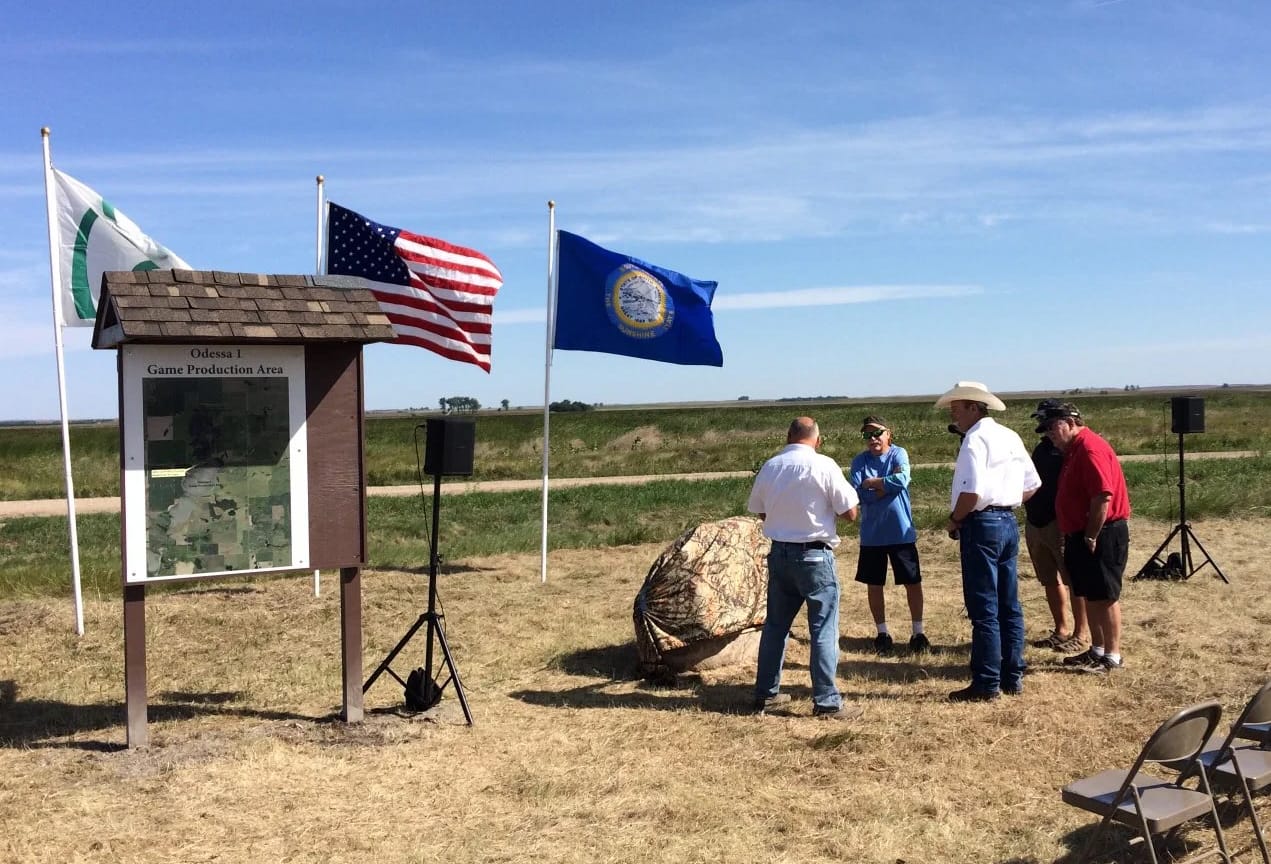
“The sportsmen of this state have strongly supported our wildlife management system and we expect and support wise, science-based, common-sense decisions impacting our valuable resources,” the letter said.
In a 2021 interview, Cooper said he never received a response from Noem to that letter or a subsequent letter he wrote to her with concerns about the bounty program.
Cooper said he was upset to learn that the bounty program was put in place without undergoing the typical public-hearing and discussion process conducted by the GFP Commission. Noem enacted the program before the commission or public had a chance to review, comment or alter it, Cooper said.
“This particular set of circumstances was really disheartening for me, that the commission was cut out of an extremely important decision-making process, and the clients, the sportsmen of South Dakota and the public, were also left out of the discussion,” Cooper said. “It was a bad mistake, and we called (Noem) out on it, and she didn’t like it.”
Program has political roots
Cooper is somewhat of a legend in South Dakota wildlife circles.
Now retired, he spent 23 years as a federal wildlife agent, served for 12 years as South Dakota GFP secretary under two Republican governors and after that was on the GFP Commission for six years. He has a wildlife-protection area named in honor of him and his wife, Vera.
He’s also concerned that such a large and expensive program to catch and kill numerous species of animals over several months of the year will upset the balance of nature.
Cooper said the program is mostly based on political concerns and not on science, and he noted that other predator-removal programs in the U.S. had previously led to exactly the opposite outcome than wildlife managers sought.
“All animals have value, all plant life has value, and if you just all of a sudden place a group of critters into this place of having no value, that they are evil and they’re taking away my ability to shoot something, you villainize them,” Cooper said “You’re not being very astute or thoughtful about wildlife and nature as a whole.”
During previous extensive, high-level policy discussions on boosting pheasant populations in South Dakota, a predator-removal or predatory bounty program never received much if any support, Cooper said. It was almost universally seen as an unproven wildlife control method that was unlikely to work, he said.
"There’s a lot of sound science on pheasants, and South Dakota has been a leader in pheasant research, habitat and biology. The bottom line is that we would a hell of a lot more rather have time, money and research put into habitat than running around paying people to trap and kill raccoons,” Cooper said.
GFP commissioner sees anecdotal evidence of success
Robert Whitmyre, a lifelong South Dakotan who farms near Webster, was appointed to the GFP Commission in 2019, after the bounty program began. He has since voted to extend the program through at least 2026.
Raccoons are not native to South Dakota and are prevalent in rural areas where pheasants and waterfowl commonly nest and breed, Whitmyre said.
Climate change and agriculture, Whitmyre said, have changed the landscape of South Dakota and provided a perfect environment for raccoons and other nest predators to thrive. Corn farming has provided a consistent food source and suitable habitat for predators, he said.
“With agriculture, we have certainly changed the cropping and changed the diet for different animals, and corn is the No. 1 reason raccoons can persist so readily in the U.S. right now,” he said.

Though he acknowledges that his evidence is entirely anecdotal, Whitmyre said he had seen more pheasants and waterfowl on his farm since the bounty program began. Whitmyre said that for the first time in nearly a decade, he had seen several successful pheasant broods on his property or nearby.
“In all honesty, I can’t definitely, absolutely say the program has contributed to an improved pheasant population,” Whitmyre said. “But I believe we do have an absolute linear relationship with predator-control numbers and pheasant-population numbers in this area.”
Program benefits public, youth and pheasants
Raccoons, skunks and other nest predators are highly prevalent on East River South Dakota farms and cause myriad problems for other species but also can bite and spread rabies to humans, Whitmyre said.
Whitmyre recalls that his mother encouraged him as a boy to kill ground squirrels on their farm and paid him a bounty of a penny per tail. He also was encouraged by his grandfather to trap and kill gophers that dig holes and cause problems for farmers.
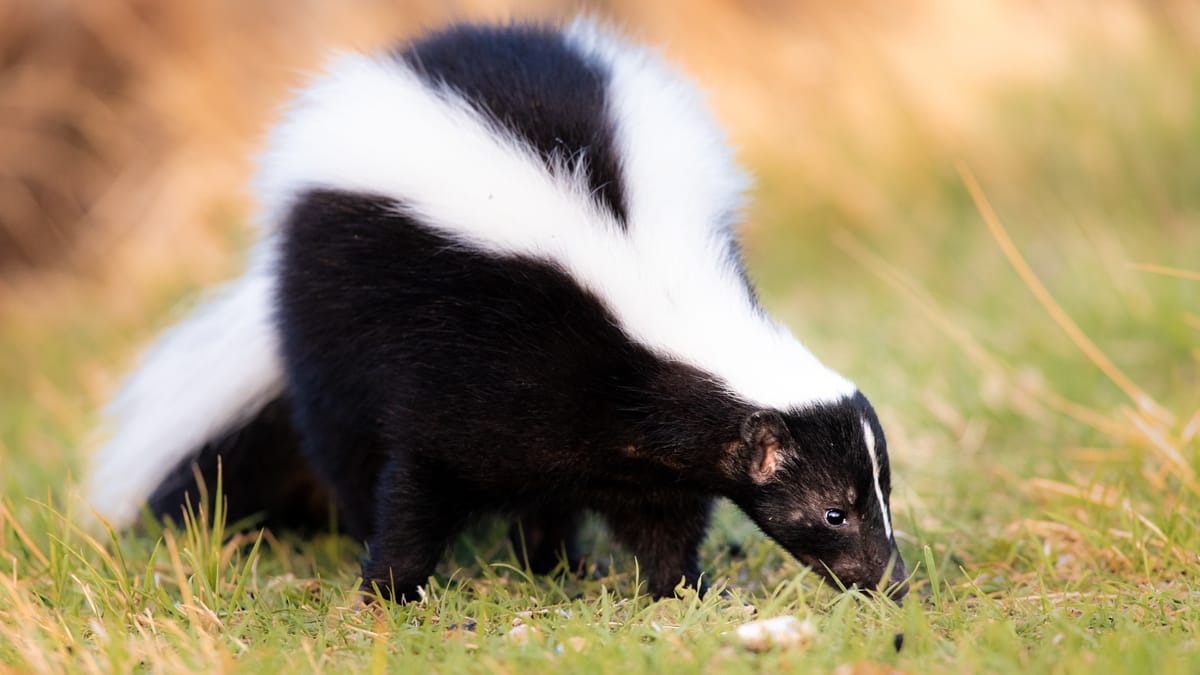
“This program gives the view that we’re enabling young people to contribute to the improvement of habitat, and those seeds will continue to grow for many years,” he said.
Beyond controlling the predator population, Whitmyre said the bounty program has had measurable success in attracting young people to trapping and other outdoor activities, which he argues is critical to continue South Dakota’s outdoor heritage and develop the next generation of sportsmen and women who sustain habitat through the purchase of licenses and support of industries surrounding outdoor recreation.
“It gives them a chance to make a few dollars but also contribute to the pheasant population and of other nesting birds and get involved in habitat improvement,” Whitmyre said. “That’s been fun to see because when it comes to all the competition for the time that young people have, with electronic games, the outdoors just kind of falls by the wayside.”
Fewer miles lead to fewer eggs
Whitmyre said the reduction of raccoons and other nest predators over time will enable more pheasants and other nesting birds to thrive because there is statistically a lower chance that predators will stumble upon active nests during their hunt for food.
“If you reduce the population of those predators, you can reduce the number of miles they’re putting on each night and reduce the incidental contact and destruction of those nests,” he said.
Female pheasants take about a month to lay and hatch all their eggs, which provides ample opportunity for predators to find and eat the eggs or hatchlings during the critical breeding period.
Whitmyre said he had also seen improvement of other species since the bounty program began, including avocets and other birds that rely on marshes and fields for breeding or for stopovers while migrating.
Animal advocate calls program ‘inhumane’
Sara Parker, a communications professional from Sioux Falls, S.D., is co-founder of South Dakotans Fighting Animal Cruelty Together, which strongly opposes the bounty program.
Parker’s group was formed about a decade ago and successfully lobbied lawmakers to make animal cruelty a felony offense. The group now has more than 5,000 Facebook followers.
On several fronts, Parker and her group oppose the bounty program, which she has called “inhumane, wasteful and not based on science” in letters published in several South Dakota newspapers.
Parker said she was disappointed that it was implemented without input from the public or the scientific community. She also said the millions spent on the program could be better used to expand habitat or other wildlife-enhancement efforts.
Parker’s biggest concerns about the program, however, center on the widespread trapping and killing of thousands of animals.
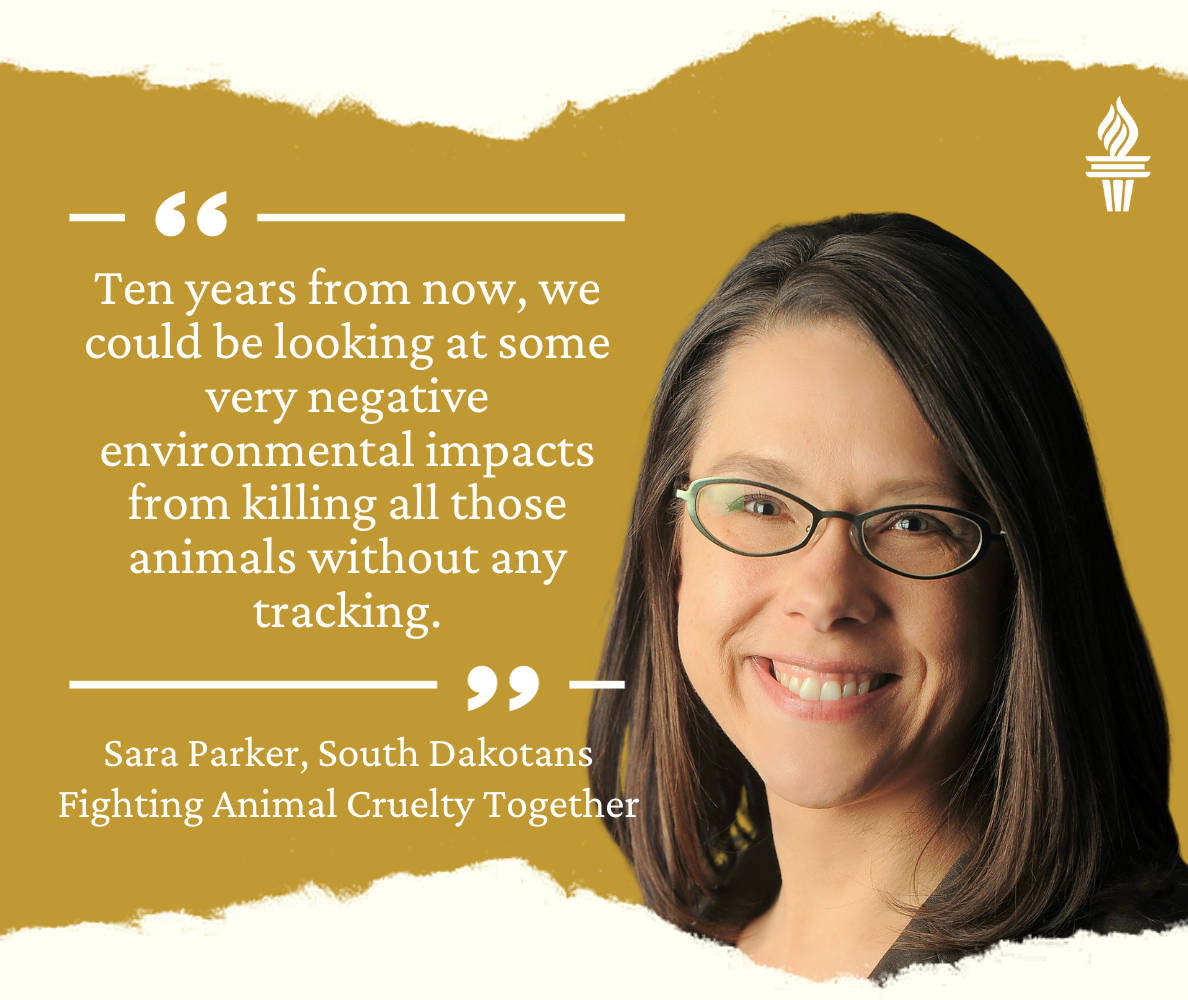
Traps are indiscriminate and can mistakenly ensnare animals not targeted under the bounty program, trapped animals can suffer for days before being killed and the offspring of trapped adult animals are left to perish alone or starve without parental help, she said.
Parker notes that animals killed under the bounty program are generally not used as food or for pelts but are left to rot after the tails are removed and collected for payment.
“This is killing for the sake of killing, because there (are) no scientific studies to support it,” she said.
Parker, who said she does not oppose hunting for food, also expressed concern that killing tens of thousands of certain species of animals will upset the balance of nature and may lead to unintended consequences that will be difficult to reverse.
“Every animal serves a purpose in that they eat a lot of mice and rats and ticks,” Parker said. “Ten years from now, we could be looking at some very negative environmental impacts from killing all those animals without any tracking.”
Parker also questions whether using money to entice children to trap and kill animals is an appropriate goal for a state-funded program.
“It’s disturbing and a little heartbreaking,” Parker said. “Of all the things to do outside, I’m not sure why this is the thing you would encourage kids to do in the outdoors. With that amount of money, there is a lot you could do to get kids outdoors.”


